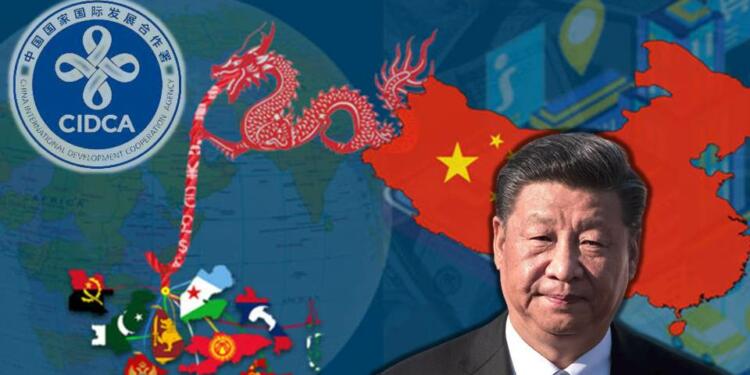Chinese diplomacy and foreign policy is heavily backed by historical events. Owing to which the Chinese government sees India as the biggest threat to its existential and expansionist policies. China, which has an upper hand over India in terms of the contemporary standards of development and growth, is witnessing stagnant growth.
On the other hand, India is the fastest growing economy of the world. The Chinese are well aware of the fact that historically the two powers have grown at the cost of others’ fall, therefore, the tectonic shift in the Chinese policy against India is aimed at bringing down the rising India. The aggressive policies aimed at India are consistent with US intelligence reports claiming that China will wage war on India after retaking Taiwan in 2024.
CIDCA: Chinese vie for expansion
A close look at the Chinese foreign policy suggests that the Xi Jinping government is trying to choke India on all fronts. Earlier, the Chinese came with the Belt and Road Initiative, and now the ‘Perspective of the Blue Economy’ is aimed at countering India in the Indian Ocean region.
The recent conclusion of the China International Development Cooperation Agency (CIDCA) with the representatives of 19 countries is in this direction. These include representatives of 19 countries and 3 international organizations.
The urgency with which China is closing in on India with its aggressive infrastructure policy on land and at sea can be seen as a long-term plan to come face to face with India. CIDCA is also seen as a counter to the Indo-Pacific cooperative alliance of QUAD and the “Security and Growth for All in the Region” (SAGAR) initiatives of India.
Moreover, the way the Chinese have been opposing and attacking India on international platforms also depicts the animosity with which the Xi Jinping administration sees India.
Also read: If BRICS has to click, then Putin needs to keep madman Xi Jinping in check
China has been allying with Pakistan on various fronts, be it the development of the Gwadar Port in contrast to the Chabahar Port initiative of India to develop the International North-South Transport Corridor or the recent development of CIDCA in opposition to Indian Ocean Rim Association (IORA) and QUAD in the Indo-Pacific region.
These are aggressive Chinese countermeasures aimed at implementing policies that deny India any strategic advantage over the Chinese.
Significance of Mortifying India
Admiral Phil Davidson, former head of the US Indo-Pacific Command, stated that the Chinese might try to retake the island of Taiwan within the next six years. As a corollary, the current aggressive policy of taking down India shows that the Chinese wish to tame India before it walks over Taiwan.
That is to say the Chinese are targeting every prospect of India’s growth story, be it the radicalization of internal security, the cornering through the Belt and Road network, or the Blue Economy plan. At the centre of the Blue Economy initiatives lie transactions with small nations, most of which China can lure into a debt trap in the name of infrastructural development.
Further, the substantial investments in ports and infrastructure in several countries, including Pakistan and Sri Lanka, provide military bases to curtail the strategic significance of India in the Indian Ocean region.
Amongst others, China has established a full-fledged naval base in Djibouti, acquired the Hambantota port in Sri Lanka on a 99-year lease, the port at Pakistan’s Gwadar, and made infrastructural investments in the Maldives. The Chinese are trying their best to challenge India and QUAD in the Indo-Pacific region.
Also read: With Pakistan firmly in China’s pocket, Sri Lanka is the new battleground of Asian century
Perks of CIDCA to China
The success of the China International Development Cooperation Agency (CIDCA) would be multifaceted for the expansionist nation. It would turn the subcontinent and its neighborhood hostile to India.
Further, China could directly challenge the Indian trade prospects in the region. In addition, it would bring China right at the India’s doorstep on all sides, and ultimately force India to refrain from going against China in case of future conflicts.
Thereby, it will ultimately help China overcome the threat of two frontal wars in the event of an invasion of Taiwan. India had been unequivocally clear about its stance on an independent Taiwan. India has more recently opposed the Chinese expansionist policy, be it the annexation of Tibet in the west or the claim over Taiwan in the east.
China to meet the Nazi fate
The “one China” policy is nothing but a replica of the fanatical expression that doomed Nazi Germany in World War II. To draw an analogy from the past, the end of China would be the same as that of Nazi Germany, as the Chinese populace is now erupting in protest against the Xi Jinping administration.
Also read: A China-Japan War looks like a-possibility and Japan will have QUAD on its side
In addition, the Chinese military had not fought a conventional war in the past 50 years and therefore lacked the tactical might to take on India. Further, the present regime of Prime Minister Modi is more strategically poised to take on China. In the event of a direct conflict with India, China would find itself extremely isolated on the global stage. Pakistan would be the only ally, but given the withering state of affairs in Pakistan, supporting China would only doom Pakistan.
India, on the other hand, has a comprehensive foreign policy and has been a good friend to the international community in times of need. Therefore, pinning down India on the economic and military fronts won’t be that easy for any nation. No matter how aggressive the Chinese government’s policy appears on paper, the next era will be that of India, not one of expansion.
Support TFI:
Support us to strengthen the ‘Right’ ideology of cultural nationalism by purchasing the best quality garments from TFI-STORE.COM































